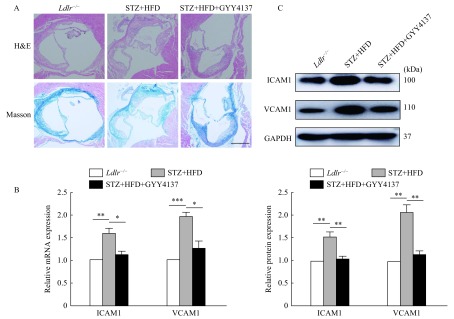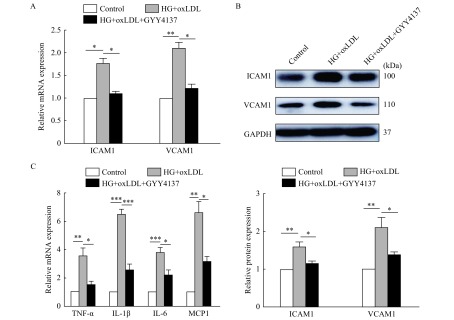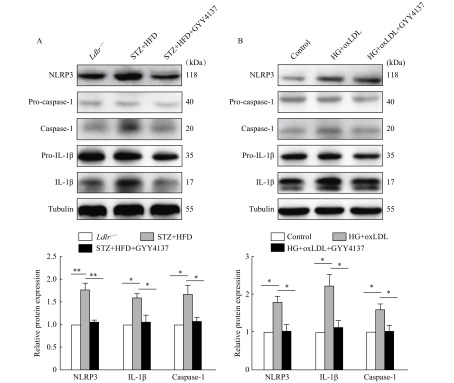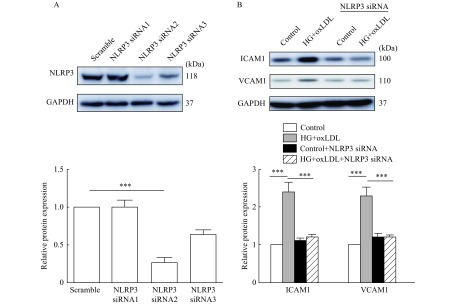Abstract
Hydrogen sulfide (H2S) is an important messenger for its strong anti-inflammatory effects, which may be involved in multiple cardiovascular diseases. In our previous study, we revealed that H2S attenuated diabetes-accelerated atherosclerosis through suppressing oxidative stress. Here we report that GYY4137, a H2S donor, reduced the plaque formation of aortic roots and the levels of both intercellular cell adhesion molecule 1 (ICAM1) and vascular cell adhesion molecule 1 (VCAM1) in diabetes-accelerated atherosclerotic cells and mouse models. The inflammatory factors of TNF-α, IL-1β, IL-6, and MCP1 were also significantly reduced by GYY4137. Mechanically, GYY4137 suppressed the activation of pyrin domain containing protein 3 (NLRP3) inflammasome in diabetes-accelerated atherosclerosis conditions. Upon knockdown of NLRP3, the increase of ICAM1 and VCAM1 caused by high glucose and oxLDL could be reversed, indicating that H2S protected the endothelium by inhibiting the activity of NLRP3 inflammasome. In conclusion, our study indicates that GYY4137 effectively protects against the development of diabetes-accelerated atherosclerosis by inhibiting inflammasome activation.
Keywords: H2S , NLRP3, inflammation, diabetes-accelerated atherosclerosis
Introduction
Diabetes-accelerated atherosclerosis is the most common cardiovascular complication in diabetes mellitus[1]. The incidence of atherosclerosis in diabetic patients is several times higher than that of non-diabetic patients, with the onset time being early, the process being fast and the mortality rate being high[2]. At present, there is a lack of an effective treatment for atherosclerosis caused by diabetes mellitus. Therefore, it is very important to explore the pathogenesis of diabetes-accelerated atherosclerosis and find the biomolecular targets for the treatment of this disease.
Hydrogen sulfide (H2S) has been considered as a toxic gas[3], but in recent years there has been growing evidence of the physiological importance of endogenous H2S, which is now recognized as a gaseous signaling molecule in organisms–"gasotransmitter", found after carbon monoxide (CO) and nitric oxide (NO)[4]. Recent evidence indicates that H2S is an important messenger that regulates the physiological and pathological functions of the body, because of its strong antioxidant and anti-inflammatory effects[5], and thus may imply its potential protective effect on a variety of diseases, especially in the cardiovascular system[6– 7]. H2S can stabilize atherosclerotic plaque, prevent ischemia-reperfusion injury[8], improve endothelial dysfunction induced by hyperglycemia[9] and protect against myocardial infarction and heart failure[6]. At present, there are few reports on the role of H2S in diabetes-accelerated atherosclerosis, and our previous studies have pointed out that H2S could promote Nrf2 activation through promoting Keap1 S-sulfhydration, thus protecting against diabetes-accelerated atherosclerosis[10]. In previous studies, we have revealed that the protective effects of H2S on diabetes-accelerated atherosclerosis were relying on the attenuation of oxidative stress and inflammation.
This study indicates that GYY4137, an H2S donor, can effectively inhibit the development of diabetes-accelerated atherosclerosis, which plays a protective role in vitro and in vivo. Moreover, H2S can inhibit the activation of pyrin domain containing protein 3 (NLRP3) inflammasome, an important inflammation signaling pathway, thus decreasing IL-1β production and eventually attenuating the pathological progress of diabetes-accelerated atherosclerosis.
Materials and methods
Cell culture and treatment
Umbilical cords of newborn babies were derived from the Third Affiliated Hospital of Nanjing Medical University. The study was approved by the Ethics Committee of the Third Affiliated Hospital of Nanjing Medical University and was performed in compliance with the Declaration of Helsinki Principles. Human umbilical vein endothelial cells (HUVECs) were isolated and cultured following the instruction of previous methods[11]. The HUVECs were cultured in endothelial cell medium (ECM, ScienCell, USA). HUVECs were treated with high glucose (25 mmol/L, Sigma, USA) and oxLDL (100 mg/L, Peking Union-Biology Co., Ltd., China), with or without GYY4137 (100 µmol/L) for 24 hours.
Western blotting analysis
Total cells or aortic tissue were lysed in appropriate volumes of RIPA lysis buffer (Beyotime Biotechnology, China) (50 mmol/L Tris-HCl, pH 8.0, 20 mmol/L EDTA, 1% SDS, 100 mmol/L NaCl) with the protease inhibitor cocktail (Thermo Fisher Scientific, USA), homogenized and gathered by centrifugation at 12 000 g for 5 minutes. Equal amounts of cells or aortic tissue were loaded and separated on 15% or 10% SDS poly-acrylamide gels and transferred to PVDF membranes. Western blotting analysis was performed with the primary antibodies included anti-intercellular cell adhesion molecule 1 (ICAM1) (sc-8439; Santa Cruz Biotechnology, USA), anti-vascular cell adhesion molecule 1 (VCAM1) (sc-13160; Santa Cruz Biotechnology), anti-GAPDH (AP0063; Bioworld, USA), anti-pro-caspase-1 (ab179515; Abcam, USA), anti-caspase-1 (ab1872; Abcam), anti-IL-1β (ab9722; Abcam) and anti-NLRP3 (ab232401; Abcam), and the secondary antibodies included Peroxidase-AffiniPure Goat Anti-Rabbit IgG (H+L) (111-036-003; Jackson, USA), Peroxidase-AffiniPure Goat Anti-Mouse IgG (H+L) (111-035-003; Jackson). Proteins were visualized by enhanced chemiluminescence substrate (Tanon, China).
Small interfering RNA transfection
NLRP3 expression was silenced by using siRNA against NLRP3 which was purchased from Genepharma (China). HUVECs were transfected with siRNA oligonucleotide following the instruction of the Lipofectamine 3000 reagent (Invitrogen, USA).
RNA isolation and quantitative real-time PCR (qRT-PCR)
The whole RNA was isolated from cells or the aortic tissues with Trizol reagent (Takara, Japan). Total mRNAs were reverse-transcribed into cDNA for subsequent analyses by using the Revert Aid First Strand cDNA Synthesis kit (Vazyme, China), according to the instruction. qRT-PCR was carried out in triplicate with the resulting cDNAs using SYBR Green Premix (Takara) and ABI 7500 Real-time PCR System (ABI, Carlsbad, USA). Primers used for qRT-PCR were purchased from Thermo Fisher Scientific. Sequences of primers involved in this paper for qRT-PCR were as follows: Human TNF-α, Forward primer (5′→3′): CCTCTCTCTAATCAGCCCTCTG, Reverse primer (5′→3′): GAGGACCTGGGAGTAGATGAG; Human IL-1β, Forward primer (5′→3′): ATGATGGCTTATTACAGTGGCAA, Reverse primer (5′→3′): GTCGGAGATTCGTAGCTGGA; Human IL-6, Forward primer (5′→3′): ACTCACCTCTTCAGAACGAATTG, Reverse primer (5′→3′): CCATCTTTGGAAGGTTCAGGTTG; Human MCP1, Forward primer (5′→3′): CAGCCAGATGCAATCAATGCC, Reverse primer (5′→3′): TGGAATCCTGAACCCACTTCT; Human ICAM1, Forward primer (5′→3′): TGACCGTGAATGTGCTCTC, Reverse primer (5′→3′): TCCCTTTTTGGGCCTGTTGT; Human VCAM1, Forward primer (5′→3′): AATGCCTGGGAAGATGGTCG, Reverse primer (5′→3′): GATGTGGTCCCCTCATTCGT; Human GAPDH, Forward primer (5′→3′): GGAGCGAGATCCCTCCAAAAT, Reverse primer (5′→3′): GGCTGTTGTCATACTTCTCATGG; Mouse ICAM1, Forward primer (5′→3′): GCTACCATCACCGTGTATTCG, Reverse primer (5′→3′): TGAGGTCCTTGCCTACTTGC; Mouse VCAM1, Forward primer (5′→3′): ACTCCCGTCATTGAGGATATTG, Reverse primer (5′→3′): TGACAGTCTCCCTTTCTTTGAG; Mouse β-actin, Forward primer (5′→3′): GGACTGTTACTGAGCTGCGTT, Reverse primer (5′→3′): CAACCAACTGCTGTCGCCTT.
Animal treatment
Male Ldlr-/- mice (specific pathogen free, SPF), on a C57BL/6 background, were derived from Model Animal Research Center of Nanjing Medical University. Streptozotocin (STZ) [60 mg/(kg·day)] was intraperitoneally injected into Ldlr-/- mice at the age of 8 weeks for 5 days without interruption. Five days later, mice were performed with GYY4137 (a H2S donor) and were fed with a high-fat diet (D12108C) for 1 month. GYY4137 [133 μmoL/(kg·day)]or saline was intraperitoneally injected. The animals were kept under standard animal room conditions [temperature (21±1) °C; humidity 55%–60%; 12–hour light : dark cycles]. The mice were anesthetized with 3.5% isoflurane and maintained with 2.0% isoflurane during the surgery. All animal experiments were carried out in accordance with the guidelines approved by the Institutional Animal Care and Use Committee of Nanjing Medical University.
Hematoxylin-eosin staining
Hematoxylin-eosin staining was conducted in the light of the instruction (Beyotime Biotechnology). Briefly, after 5 μm sections were deparaffinized and rehydrated, sections were dipped in hematoxylin solution for 10 minutes. Then, the sections were dipped in 1% acid ethanol (1% HCl in 70% ethanol) for 5 times and then washed in ultra-pure water for 20 minutes. The sections were then dipped in eosin solution for 3 minutes, and then dehydrated in graded ethyl alcohol and washed in xylene. Finally, the handled slides were then checked and photographed under a microscope (Olympus, Japan).
Masson's trichrome staining
After deparaffinization and rehydration, using graded ethyl alcohol, sections were washed in ultra-pure water for 1 minute and then dipped in Weigert's iron hematoxylin working solution (Beyotime Biotechnology) for 10 minutes. Sections were then washed under warm running water for 10 minutes before being twice washed in ultra-pure water. The sections were next dipped in Biebrich scarlet-acid fuchsin solution for 10–15 minutes. Wash the sections in ultra-pure water for 2 times. The sections were then differentiated in phosphomolybdic-phosphotungstic acid solution for 10 –15 minutes while waiting for the collagen no longer turned red. Sections were then transferred directly to the aniline blue solution and tarnished for 5–10 minutes before being washed in ultra-pure water, then washed in ultra-pure water and differentiated in 1% acetic acid solution for 2 –5 minutes. Finally, sections were washed with ultra-pure water, dehydrated in a gradient of ethanol and washed in xylene. The handled slides were then checked and photographed under a microscope (Olympus).
Statistical analysis
All data are expressed as mean±standard error of mean (mean±SEM). Gray value of the bands was analyzed by ImageJ software. Distribution of the data was first analyzed using the Kolmogorov-Smirnov test for analysis of normality. Depending on the number of experimental groups and factors to be compared, statistical analysis was performed with Student's t-test or one-way ANOVA followed by post hoc test (Bonferroni). Otherwise, Johnson transformation was applied to transform the data. P<0.05 was considered statistically significant. Statistical analysis was done with GraphPad Prism 5 (GraphPad Software Inc, San Diego, USA).
Results
H2S protects against diabetes-accelerated atherosclerosis in diabetic Ldlr-/- mice
To determine the effect of H2S on the endothelium of diabetes-accelerated atherosclerosis mouse models, mice were injected intraperitoneally with GYY4137 or saline for 4 weeks. Meanwhile, they were kept on a high fat diet (HFD) to accelerate atherogenesis. The plaque area and collagen deposition in the aortic roots of mice's hearts were performed. As expected, treatment of diabetic Ldlr-/- mice with H2S significantly reduced atherosclerotic plaques and collagen deposition compared with the Ldlr-/- mice (Fig. 1A). We also found a significant decrease in the expression of intercellular cell adhesion molecule 1(ICAM1) and vascular cell adhesion molecule 1(VCAM1), both at mRNA levels (Fig. 1B) and protein levels ( Fig. 1C). Collectively, these results revealed that exogenous H2S decreased atherosclerotic lesions and ICAM1 and VCAM1 expression in diabetes-accelerated atherosclerosis mouse models.
1. H2S reduced plaque formation of aortic roots and the levels of ICAM1 and VCAM1 in diabetic Ldlr-/- mice.
A: Representative images of cross-sections of aortic roots of non-diabetic, diabetic, and diabetic treated with GYY4137 after 4 weeks of a high fat diet. Sections were stained with H&E (top) and Masson's trichrome staining (bottom) (scale bar =100 μm). B: Total mRNAs were extracted from the aortic tissues and gene expression levels of ICAM1 and VCAM1 were determined by qRT-PCR (*P<0.05,**P<0.01,***P<0.001,n=3). C: Total proteins were extracted from aortic tissues and analyzed by Western blotting assay to determine the levels of ICAM1 and VCAM1 expression (**P<0.01,n=3). STZ: streptozotocin; HFD: high fat diet.
H2S reduced the expression of ICAM1 and VCAM1, and inflammation factors in vitro
To further investigate the protective effects of H2S, we established a HUVECs model treated with high glucose (25 mmol/L) and oxidized low density lipoprotein (oxLDL, 100 mg/L) in vitro, which could replicate some of the features of endothelial cells in the diabetes-accelerated atherosclerotic mouse models. We examined the expression of adhesion molecules ICAM1 and VCAM1 (Fig. 2A and B) as well as inflammatory factors of tumor necrosis factor-α (TNF-α), interleukine-1β (IL-1β), interleukin 6 (IL-6), monocyte chemoattractant protein 1 (MCP1) (Fig. 2C) in the HUVECs of high glucose and oxLDL treatments. The increase of ICAM1 and VCAM1 induced by high glucose and oxLDL were reversed by H2S. The same changes were observed in inflammatory factors. These results demonstrated that H2S could reduce inflammation in vitro.
2. H2S reduced the expression of ICAM1 and VCAM1, and inflammatory factors in vitro.
HUVECs were treated with high glucose and oxLDL, with or without GYY4137 for 24 hours. A: Total mRNAs were extracted and gene expression levels of ICAM1 and VCAM1 were determined by qRT-PCR (*P<0.05,**P<0.01,n=3). B: Total proteins were extracted and analyzed by Western blotting assay to determine the level of ICAM1 and VCAM1 expression (*P<0.05,**P<0.01,n=3). C: Total mRNAs were extracted and gene expression levels of TNF-α, IL-1β, IL-6 and MCP1 were determined by qRT-PCR (*P<0.05,**P<0.01,***P<0.001,n=3). HG: high glucose.
H2S decreased the activation of NLRP3 inflammasome in vivo and in vitro
The above results suggested that the inflammatory response plays a vital role in the pathological process of diabetes-accelerated atherosclerotic. Therefore, we detected the activation of caspase-1 and IL-1β, and the expression of NLRP3 (Fig. 3A) which could reflect the inflammatory infiltration in the aortic tissues of diabetic Ldlr-/- mice. Moreover, diabetic mice demonstrated an obvious increase in caspase-1 and IL-1β as well as the expression of NLRP3, compared with the non-diabetic control. In addition, the treatment of diabetic Ldlr-/- mice with GYY4137 could also reverse these changes. We next verified these in vitro with the same results (Fig. 3B). Together, these experiments indicated that H2S decreased the activation of NLRP3 inflammasome in diabetes-accelerated atherosclerotic cells and mouse models.
3. H2S inhibited the activity of NLRP3 inflammasome in vivo and in vitro.
A: Total proteins was extracted from the aortic tissues and analyzed by Western blotting assay to determine the levels of pro-caspase-1, caspase-1, pro-IL-1β, IL-1β and NLRP3 expression (*P<0.05,**P<0.01,n=3). B: HUVECs were treated with high glucose and oxLDL, with or without GYY4137 for 2 hours. The control group means without any treatment. Total proteins were extracted from cells and analyzed by Western blotting assay to determine the level of pro-caspase-1, caspase-1, pro-IL-1β, IL-1β and NLRP3 expression (*P<0.05,n=3). STZ: streptozotocin; HFD: high fat diet; HG: high glucose.
Down-regulation of NLRP3 attenuated endothelial injury in vitro
The above results suggested that H2S may participate in diabetes-accelerated atherosclerotic by inhibiting inflammasome. To further verify this, we knocked down the expression of NLRP3 with siRNA (Fig. 4A), and then detected the expression of adhesion molecules ICAM1 and VCAM1 (Fig. 4B). Silencing of NLRP3 significantly reduced the expression of ICAM1 and VCAM1 in high glucose and oxLDL-treated HUVECs compared with that of control. In conclusion, H2S can protect endothelial injury from high glucose and oxLDL treatment by inhibiting NLRP3 inflammasome.
4. Silencing NLRP3 suppressed ICAM1 and VCAM1 expression in vitro.
A: HUVECs were transfected with scramble or NLRP3 siRNA for 48 hours. Total proteins were extracted and analyzed by Western blotting assay to determine interference efficiency. B: HUVECs were transfected with control siRNA or NLRP3 siRNA for 24 hours and then treated with high glucose and oxLDL (***P<0.001,n=3). Total proteins were extracted and analyzed by Western blotting assay to determine the level of ICAM1 and VCAM1 expression (***P<0.001,n=3). HG: high glucose.
Discussion
Diabetes-accelerated atherosclerosis is closely related to oxidative stress and inflammatory response[12]. High glucose-induced the increase of superoxide may be a key event leading to atherosclerosis[13–16], so suppressing oxidative stress is an important measure to attenuate atherosclerosis caused by diabetes. Our previous research also reported that the anti-oxidative stress of H2S could effectively delay the progression of diabetes-accelerated atherosclerosis caused by high glucose and oxLDL[10]. Moreover, GYY4137 is expected to become a drug for the treatment of diabetes-accelerated atherosclerosis caused by oxidative stress with its effective release of H2S at a physiological concentration.
In our previous studies, we found that significant lipid plaques formed in the aortic roots of the Ldlr-/- mice of high fat diet and STZ-induced diabetes-accelerated atherosclerosis, and H2S could effectively inhibit plaque formation. Additionally, vascular oxidation is effectively reduced by activating the Nrf2 signaling pathway[10,17–18]. We also found that macrophages infiltration was evident in high fat and STZ-induced diabetes-accelerated atherosclerosis mouse models, suggesting that the inflammation also plays a role in the pathological process. H2S treatment could significantly reduce the extent of macrophages infiltration and inhibit the inflammatory response. Based on this finding, we have now studied and demonstrated that H2S could not only protect against atherosclerosis in diabetes through inhibiting oxidative stress, but also prevent the progression of the disease through the attenuation of inflammatory response.
GYY4137, a H2S donor, could inhibit inflammation-related diseases such as peritonitis and acute ventilation by inhibiting the activation of NLRP3 inflammasome and reducing caspase-1 activation and IL-1β secretion[19– 20]. GYY4137 also protects against amyloid beta-peptide induced neuronal injury viaattenuating inflammatory response[7]. GYY4137 attenuates myocardial ischemia and reperfusion injury by reducing oxidative stress and apoptosis in rats[21]. In cardiovascular diseases, H2S regulates the inflammatory response of macrophages by inhibiting the activation of NLRP3 inflammasome, reducing caspase-1 activation and IL-1β secretion. Additionally, NLRP3 inflammasome is closely related to endothelial function[22]. However, the role of NLRP3 in diabetes-accelerated atherosclerosis has not been reported. The above reports suggested that H2S may reduce inflammation by reducing the activation of NLRP3 inflammasome and play a key role in the protection of diabetes-accelerated atherosclerosis.
To construct type 1 diabetes, Ldlr-/- mice were intraperitoneally injected with STZ and kept on a HFD to induce diabetes-accelerated atherosclerosis mouse models. Moreover, endothelial cells were treated with high-glucose and oxLDL to mimic diabetes-accelerated atherosclerosis induced cell injury[23]. In the endothelial injury, we found that the expression of ICAM1 and VCAM1 was significantly increased in vivo and in vitro. At the same time, we tested the mRNA expression levels of various inflammatory factors. The expression of inflammatory factors increased in high-glucose and oxLDL-treated endothelial cells, while significantly declined after H2S pretreatment. Thus, H2S plays an important role in inhibiting inflammation of diabetes-accelerated atherosclerosis. It is worth noting that we have demonstrated that high glucose and oxLDL can induce the activation of NLRP3 inflammasome, leading to the activation of caspase-1 and the production of the pro-inflammatory cytokine IL-1β. H2S could significantly inhibit these effects (Fig. 5). The silencing of NLRP3 significantly reduced caspase-1 activation, IL-1β production, ICAM1 and VCAM1 expression in high glucose and oxLDL-treated endothelial cells.
5. GYY4137 can effectively protect against the development of diabetes-accelerated atherosclerosis through inhibiting inflammasome activation.
Taken together, our experiments demonstrated that H2S delayed the progression of diabetes-accelerated atherosclerosis in Ldlr-/- mice and improved high glucose and oxLDL-induced endothelial cell injury. H2S reduced the activation of NLRP3 inflammasome in endothelial cell injury and diabetes-accelerated atherosclerosis mouse models. H2S donors have therapeutic potential for cancer, erectile dysfunction, peptic ulcer disease, Parkinson's and Alzheimer's diseases, acute and chronic inflammatory diseases, atherosclerosis, arterial and pulmonary hypertension and heart failure, among other diseases[24]. Several drugs (such as statins[25], aspirin[26], and metformin[27]) are also found to regulate H2S production, but the mechanisms and clinical significance are not fully understood. Our findings provide new evidence for the treatment of cardiovascular diseases by H2S donors.
Acknowledgments
This work was supported by grant from National Nature Science Foundation of China (Grant No. 81820108002).
References
- 1.Forbes JM, Cooper ME Mechanisms of diabetic complications. Physiol Rev. 2013;93(1):137–188. doi: 10.1152/physrev.00045.2011. [DOI] [PubMed] [Google Scholar]
- 2.Eckel RH, Wassef M, Chait A, et al Prevention conference Ⅵ: diabetes and cardiovascular disease: writing group Ⅱ: pathogenesis of atherosclerosis in diabetes. Circulation. 2002;105(18):e138–e143. doi: 10.1161/01.cir.0000013954.65303.c5. [DOI] [PubMed] [Google Scholar]
- 3.Fiedler N, Kipen H, Ohman-Strickland P, et al Sensory and cognitive effects of acute exposure to hydrogen sulfide. Environ Health Perspect. 2008;116(1):78–85. doi: 10.1289/ehp.10531. [DOI] [PMC free article] [PubMed] [Google Scholar]
- 4.He JT, Li HQ, Yang L, et al Role of hydrogen sulfide in cognitive deficits: evidences and mechanisms. Eur J Pharmacol. 2019;849:146–153. doi: 10.1016/j.ejphar.2019.01.072. [DOI] [PubMed] [Google Scholar]
- 5.Qin M, Long F, Wu WJ, et al Hydrogen sulfide protects against DSS-induced colitis by inhibiting NLRP3 inflammasome. Free Radic Biol Med. 2019;137:99–109. doi: 10.1016/j.freeradbiomed.2019.04.025. [DOI] [PubMed] [Google Scholar]
- 6.Suzuki K, Olah G, Modis K, et al Hydrogen sulfide replacement therapy protects the vascular endothelium in hyperglycemia by preserving mitochondrial function. Proc Natl Acad Sci USA. 2011;108(33):13829–13834. doi: 10.1073/pnas.1105121108. [DOI] [PMC free article] [PubMed] [Google Scholar]
- 7.Zhou X, An GY, Lu X Hydrogen sulfide attenuates the development of diabetic cardiomyopathy. Clin Sci (Lond) 2015;128(5):325–335. doi: 10.1042/CS20140460. [DOI] [PubMed] [Google Scholar]
- 8.Peake BF, Nicholson CK, Lambert JP, et al Hydrogen sulfide preconditions the db/db diabetic mouse heart against ischemia-reperfusion injury by activating Nrf2 signaling in an Erk-dependent manner. Am J Physiol Heart Circ Physiol. 2013;304(9):H1215–H1224. doi: 10.1152/ajpheart.00796.2012. [DOI] [PMC free article] [PubMed] [Google Scholar]
- 9.Luo TY, Yang YH, Xu YC, et al Dietary methionine restriction improves glucose metabolism in the skeletal muscle of obese mice. Food Funct. 2019;10(5):2676–2690. doi: 10.1039/C8FO02571A. [DOI] [PubMed] [Google Scholar]
- 10.Xie LP, Gu Y, Wen ML, et al Hydrogen sulfide induces Keap1 S-sulfhydration and suppresses diabetes-accelerated atherosclerosis via Nrf2 activation. Diabetes. 2016;65(10):3171–3184. doi: 10.2337/db16-0020. [DOI] [PMC free article] [PubMed] [Google Scholar]
- 11.Ferro A, Queen LR, Priest RM, et al Activation of nitric oxide synthase by β2-adrenoceptors in human umbilical vein endothelium in vitro . Br J Pharmacol. 1999;126(8):1872–1880. doi: 10.1038/sj.bjp.0702512. [DOI] [PMC free article] [PubMed] [Google Scholar]
- 12.Silverberg JI Comorbidities and the impact of atopic dermatitis. Ann Allergy Asthma Immunol. 2019;123(2):144–151. doi: 10.1016/j.anai.2019.04.020. [DOI] [PubMed] [Google Scholar]
- 13.Kong YL, Tong Y, Chen C, et al Alleviation of high-fat diet-induced atherosclerosis and glucose intolerance by a novel GLP-1 fusion protein in ApoE−/− mice . Endocrine. 2016;53(1):71–80. doi: 10.1007/s12020-015-0831-3. [DOI] [PubMed] [Google Scholar]
- 14.Mani S, Li HZ, Untereiner A, et al Decreased endogenous production of hydrogen sulfide accelerates atherosclerosis. Circulation. 2013;127(25):2523–2534. doi: 10.1161/CIRCULATIONAHA.113.002208. [DOI] [PubMed] [Google Scholar]
- 15.Wang XH, Wang F, You SJ, et al Dysregulation of cystathionine γ-lyase (CSE)/hydrogen sulfide pathway contributes to ox-LDL-induced inflammation in macrophage. Cell Signal. 2013;25(11):2255–2262. doi: 10.1016/j.cellsig.2013.07.010. [DOI] [PubMed] [Google Scholar]
- 16.Wang YF, Zhao X, Jin HF, et al Role of hydrogen sulfide in the development of atherosclerotic lesions in apolipoprotein E knockout mice. Arterioscler Thromb Vasc Biol. 2009;29(2):173–179. doi: 10.1161/ATVBAHA.108.179333. [DOI] [PubMed] [Google Scholar]
- 17.Barajas B, Che N, Yin F, et al NF-E2-related factor 2 promotes atherosclerosis by effects on plasma lipoproteins and cholesterol transport that overshadow antioxidant protection. Arterioscler Thromb Vasc Biol. 2011;31(1):58–66. doi: 10.1161/ATVBAHA.110.210906. [DOI] [PMC free article] [PubMed] [Google Scholar]
- 18.Holland R, Fishbein JC Chemistry of the cysteine sensors in Kelch-like ECH-associated protein 1. Antioxid Redox Signal. 2010;13(11):1749–1761. doi: 10.1089/ars.2010.3273. [DOI] [PMC free article] [PubMed] [Google Scholar]
- 19.Manna P, Jain SK L-cysteine and hydrogen sulfide increase PIP3 and AMPK/PPARγ expression and decrease ROS and vascular inflammation markers in high glucose treated human U937 monocytes. J Cell Biochem. 2013;114(10):2334–2345. doi: 10.1002/jcb.24578. [DOI] [PubMed] [Google Scholar]
- 20.Wu DD, Zhong PY, Wang J, et al Exogenous hydrogen sulfide mitigates LPS + ATP-induced inflammation by inhibiting NLRP3 inflammasome activation and promoting autophagy in L02 cells. Mol Cell Biochem. 2019;457(1–2):145–156. doi: 10.1007/s11010-019-03519-6. [DOI] [PubMed] [Google Scholar]
- 21.Meng GL, Wang J, Xiao YJ, et al GYY4137 protects against myocardial ischemia and reperfusion injury by attenuating oxidative stress and apoptosis in rats. J Biomed Res. 2015;29(3):203–213. doi: 10.7555/JBR.28.20140037. [DOI] [PMC free article] [PubMed] [Google Scholar]
- 22.Xiao L, Liu YH, Wang NP New paradigms in inflammatory signaling in vascular endothelial cells. Am J Physiol Heart Circ Physiol. 2014;306(3):H317–H325. doi: 10.1152/ajpheart.00182.2013. [DOI] [PubMed] [Google Scholar]
- 23.Venkatesan B, Valente AJ, Das NA, et al CIKS (Act1 or TRAF3IP2) mediates high glucose-induced endothelial dysfunction. Cell Signal. 2013;25(1):359–371. doi: 10.1016/j.cellsig.2012.10.009. [DOI] [PMC free article] [PubMed] [Google Scholar]
- 24.Bełtowski J Hydrogen sulfide in pharmacology and medicine-an update. Pharmacol Rep. 2015;67(3):647–658. doi: 10.1016/j.pharep.2015.01.005. [DOI] [PubMed] [Google Scholar]
- 25.Voloshchuk N, Melnik A, Danchenko O, et al The state of the cystathionine gamma-lyase/H2S system in the liver and skeletal muscles of rats with hypercholesterolemia under simvastatin administration . Georgian Med News. 2018;6(279):150–155. [PubMed] [Google Scholar]
- 26.Magierowski M, Magierowska K, Surmiak M, et al The effect of hydrogen sulfide-releasing naproxen (ATB-346) versus naproxen on formation of stress-induced gastric lesions, the regulation of systemic inflammation, hypoxia and alterations in gastric microcirculation. J Physiol Pharmacol. 2017;68(5):749–756. [PubMed] [Google Scholar]
- 27.Sun LH, Wu YL, Chen JJ, et al A turn-on optoacoustic probe for imaging metformin-induced upregulation of hepatic hydrogen sulfide and subsequent liver injury. Theranostics. 2019;9(1):77–89. doi: 10.7150/thno.30080. [DOI] [PMC free article] [PubMed] [Google Scholar]







